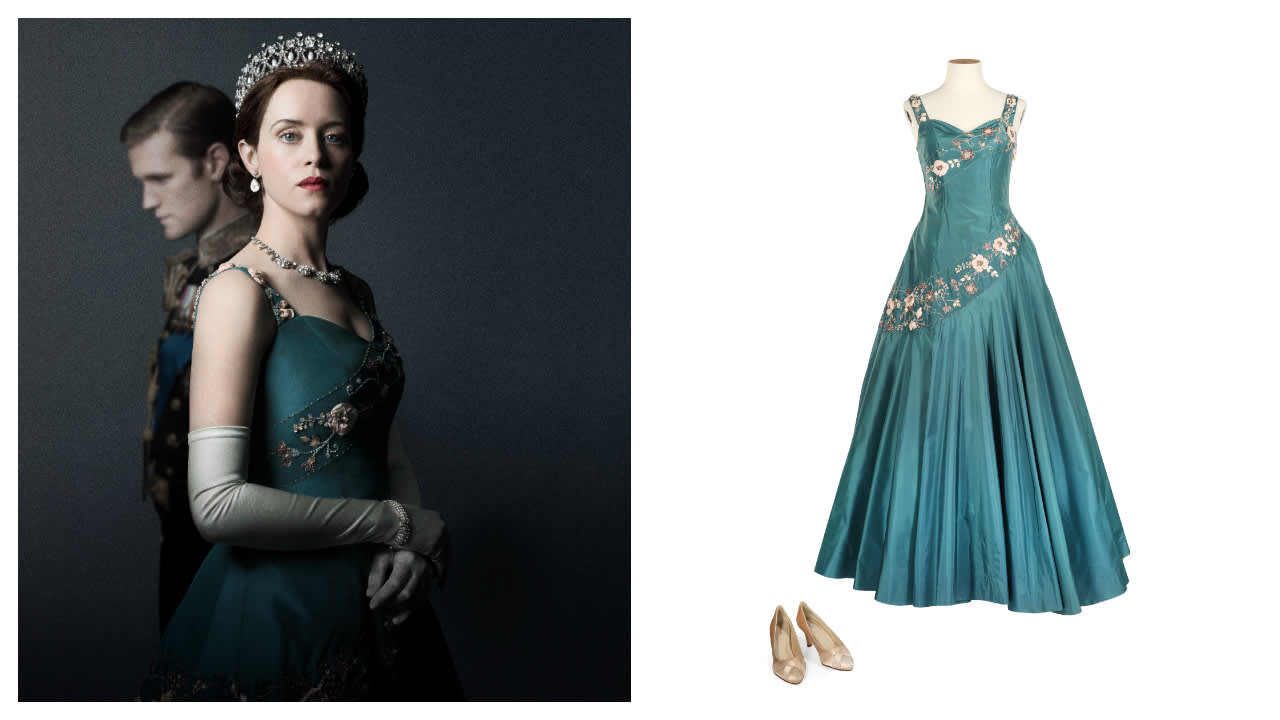Costumes and Props From ‘The Crown’ Head to Auction
Fans of The Crown will soon have the opportunity to own a piece of the royal drama as Bonhams is auctioning off a range of items from the Netflix series, which ended its six-season run in December.
More than 300 lots are currently available for online bidding through Feb. 8, and an additional 160 will go under the hammer during a live sale at Bonhams’ London headquarters on Feb. 7.
Since its debut in late 2016, The Crown has captivated viewers around the world with its visually stunning approach and dramatic portrayal of the British royal family’s tales of heartbreak. Throughout the show’s 60 episodes, viewers followed the twists and turns of the royals.
“The iconic costumes, props, and set pieces from The Crown are extensively researched and made with truly impressive attention to detail by master craftspeople,” Charlie Thomas, Bonhams U.K. group director for house sales and private and iconic collections, said in a statement. “Not only is this an incredible opportunity to own pieces from the landmark show, it is also the closest anyone can come to owning the real thing—be it the facade of 10 Downing Street or Princess Diana’s engagement ring.”

Composite: Courtesy of Bonhams / Netflix
Highlights of the auction include recreations of Princess Diana’s iconic items, such as the sapphire engagement ring that actress Emma Corrin debuted as Diana in season 4 (presale estimate: £2,000 (US$2,537) to £3,000); the revenge dress actress Elizabeth Debicki wore as Diana during her split from then-Prince Charles in season 5 (estimate: £8,000 to £12,000); and the leopard swimsuit Debicki sported in season 6 while on vacation during Charles’ 50th birthday party for then-Camilla Parker Bowles (estimate: £800 to £1,000).

Composite: Courtesy of Bonhams / Netflix
Expected to fetch the highest prices are a pair of life-size replicas from the set: the Gold State Coach, which is estimated to sell for between £30,000 and £50,000, and a facade of 10 Downing Street, the British prime minister’s office and residence (estimate: £20,000 to £30,000).
Described by Bonhams as a “rococo masterpiece,” the actual royal coach was built in 1762 for King George III and has been used at every coronation since 1831, when King William IV succeeded to the throne.
“We wanted to make something special, and Netflix had the money, ambition, and ability to go the whole hog. The Gold State Coach is fabulous,” said Andy Harries, CEO Left Bank Pictures and executive producer of The Crown, in the auction notes.
Gene D’Cruze, the series’ head of construction, said the items for sale are among the most impressive and accurate recreations ever committed to film.

Composite: Courtesy of Bonhams / Netflix
“I’ve built every single set on every series—more than 1,000 of them—and employed 140 people. It’s all done old-school. I’ve done 80 TV series, but The Crown is the best—best production, best art department, best locations, best series, best people,” said D’Cruze in the auction notes. “I especially love the 10 Downing Street facade. Most sets only last six months, but this stood for seven years.”
Proceeds from the live auction will go toward establishing a new scholarship for students at the National Film and Television School (NTFS). According to the auction house, the program will support students at the globally renowned school over the next 20 years.
“The Crown’s huge global success has much to do with working with the best creative and production talent in this country and we want to invest the proceeds of this magnificent auction into the next generation of film and TV talent,” said Harries in a statement.
A special exhibition of items from the auction has been on a global tour—having already appeared in New York, Los Angeles, and Paris—and will remain on display at Bonhams London through Feb 5.
 Copyright 2020, Dow Jones & Company, Inc. All Rights Reserved Worldwide. LEARN MORE
Copyright 2020, Dow Jones & Company, Inc. All Rights Reserved Worldwide. LEARN MORE
This stylish family home combines a classic palette and finishes with a flexible floorplan
Just 55 minutes from Sydney, make this your creative getaway located in the majestic Hawkesbury region.
Continued stagflation and cost of living pressures are causing couples to think twice about starting a family, new data has revealed, with long term impacts expected
Australia is in the midst of a ‘baby recession’ with preliminary estimates showing the number of births in 2023 fell by more than four percent to the lowest level since 2006, according to KPMG. The consultancy firm says this reflects the impact of cost-of-living pressures on the feasibility of younger Australians starting a family.
KPMG estimates that 289,100 babies were born in 2023. This compares to 300,684 babies in 2022 and 309,996 in 2021, according to the Australian Bureau of Statistics (ABS). KPMG urban economist Terry Rawnsley said weak economic growth often leads to a reduced number of births. In 2023, ABS data shows gross domestic product (GDP) fell to 1.5 percent. Despite the population growing by 2.5 percent in 2023, GDP on a per capita basis went into negative territory, down one percent over the 12 months.
“Birth rates provide insight into long-term population growth as well as the current confidence of Australian families,” said Mr Rawnsley. “We haven’t seen such a sharp drop in births in Australia since the period of economic stagflation in the 1970s, which coincided with the initial widespread adoption of the contraceptive pill.”
Mr Rawnsley said many Australian couples delayed starting a family while the pandemic played out in 2020. The number of births fell from 305,832 in 2019 to 294,369 in 2020. Then in 2021, strong employment and vast amounts of stimulus money, along with high household savings due to lockdowns, gave couples better financial means to have a baby. This led to a rebound in births.
However, the re-opening of the global economy in 2022 led to soaring inflation. By the start of 2023, the Australian consumer price index (CPI) had risen to its highest level since 1990 at 7.8 percent per annum. By that stage, the Reserve Bank had already commenced an aggressive rate-hiking strategy to fight inflation and had raised the cash rate every month between May and December 2022.
Five more rate hikes during 2023 put further pressure on couples with mortgages and put the brakes on family formation. “This combination of the pandemic and rapid economic changes explains the spike and subsequent sharp decline in birth rates we have observed over the past four years,” Mr Rawnsley said.
The impact of high costs of living on couples’ decision to have a baby is highlighted in births data for the capital cities. KPMG estimates there were 60,860 births in Sydney in 2023, down 8.6 percent from 2019. There were 56,270 births in Melbourne, down 7.3 percent. In Perth, there were 25,020 births, down 6 percent, while in Brisbane there were 30,250 births, down 4.3 percent. Canberra was the only capital city where there was no fall in the number of births in 2023 compared to 2019.
“CPI growth in Canberra has been slightly subdued compared to that in other major cities, and the economic outlook has remained strong,” Mr Rawnsley said. “This means families have not been hurting as much as those in other capital cities, and in turn, we’ve seen a stabilisation of births in the ACT.”
This stylish family home combines a classic palette and finishes with a flexible floorplan
Just 55 minutes from Sydney, make this your creative getaway located in the majestic Hawkesbury region.





















